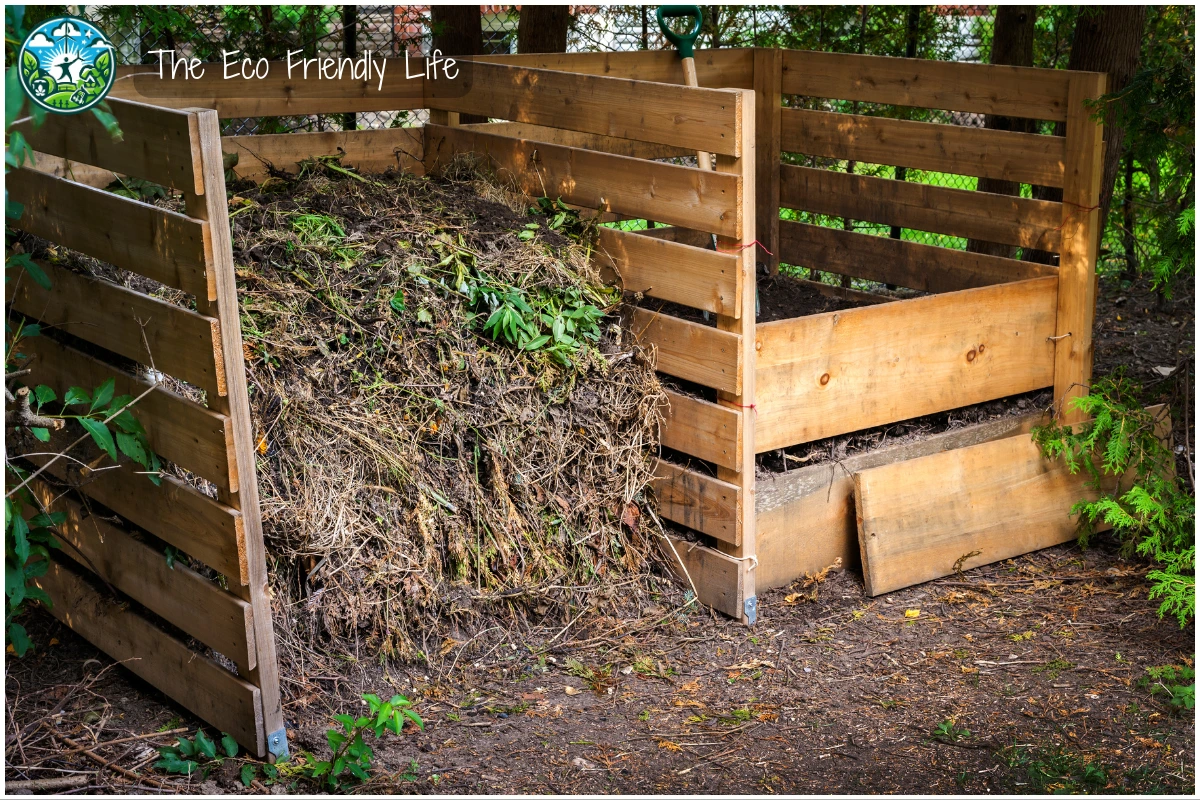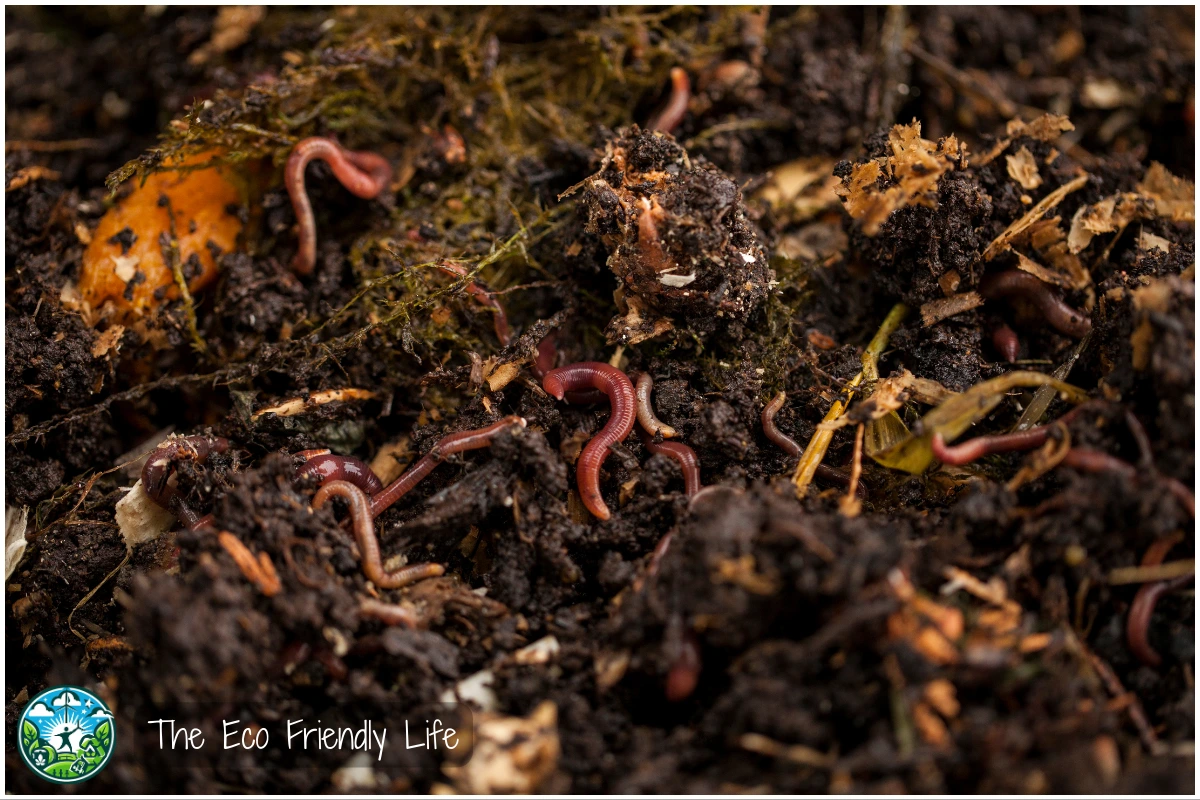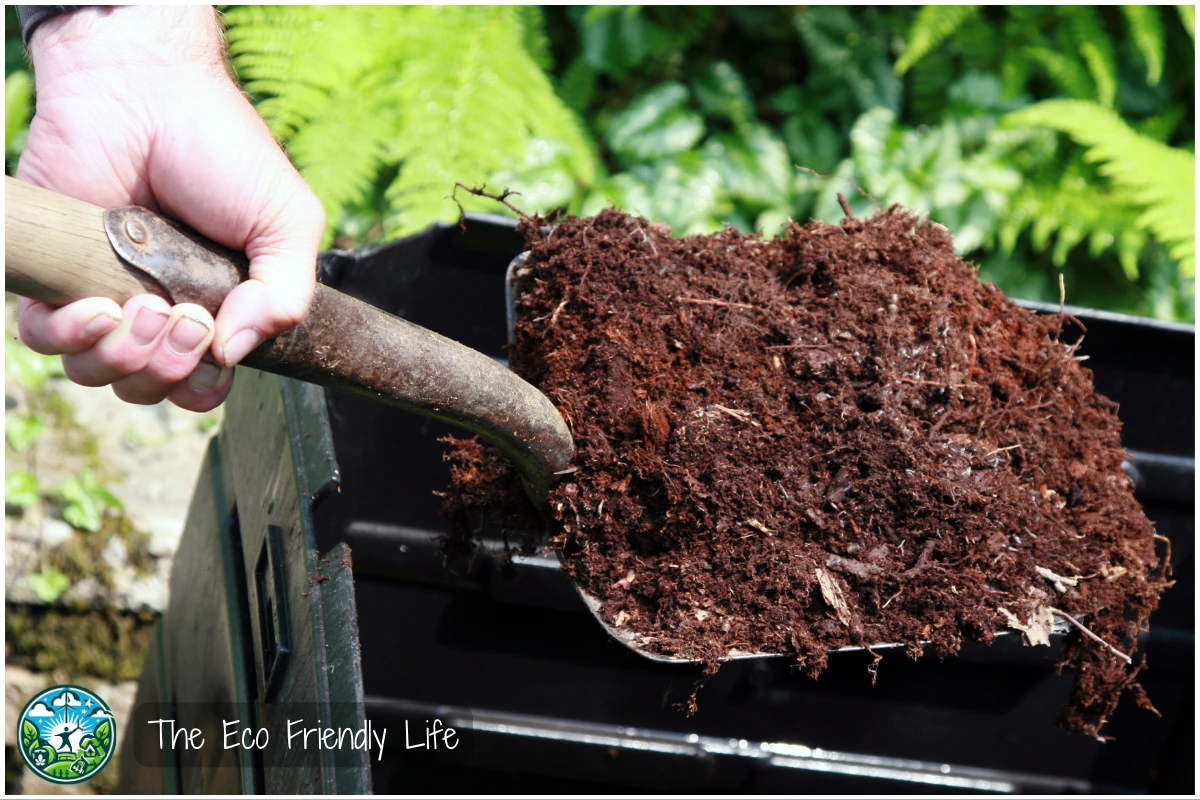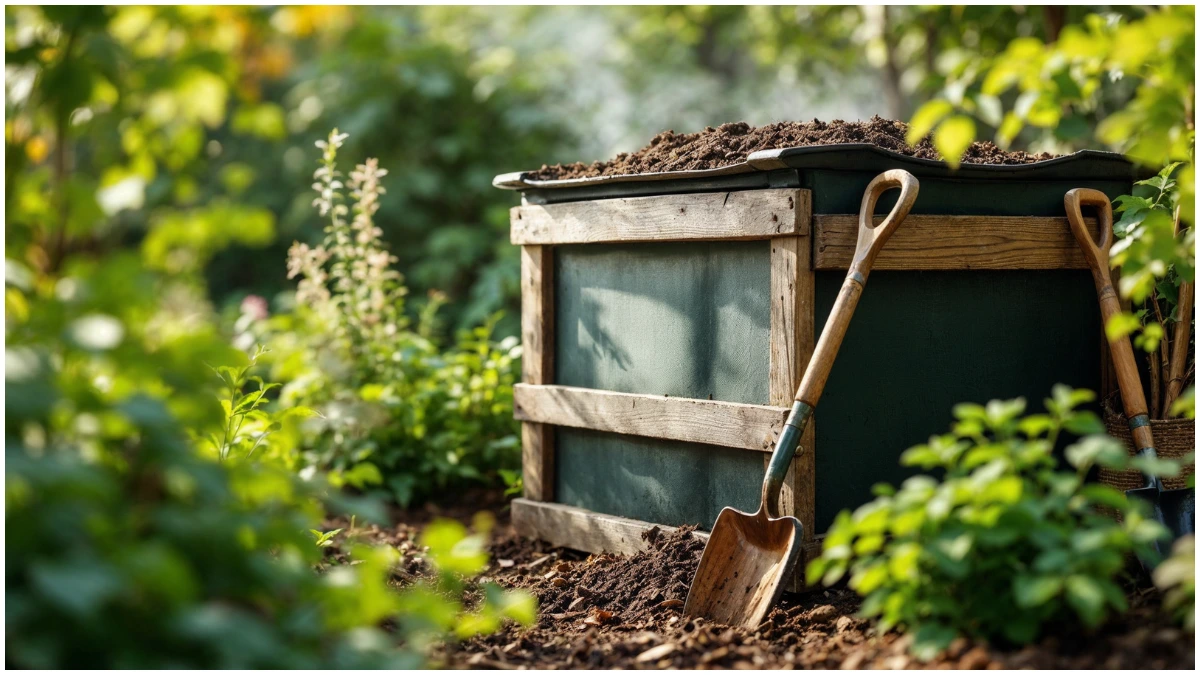Hi, it’s Al with you, and welcome back to The Eco-Friendly Life. Today, we’re diving into how to compost at home for beginners, a simple first step toward sustainable living. Composting at home transforms organic waste into nutrient-rich soil, benefiting both your garden and the environment.
We’ll discuss the environmental impact of organic waste, the process of turning waste into valuable compost, and how this practice saves money and nurtures biodiversity. Join me as we explore the benefits of composting and guide you through setting up your home compost system. Let’s get started!

Why Composting at Home Enriches Your Garden and the Planet
Mind Your Waste Impact: I’ve grown increasingly mindful of the environmental imprint left by everyday waste, especially organic material. Did you know that when your apple cores and potato peels end up in a landfill, they’re far from harmless? In the absence of oxygen, these natural items decompose anaerobically, releasing methane into the atmosphere, a potent greenhouse gas.
Transform Waste Into Black Gold: Contrast this with the process of composting at home. It transforms what would have been waste into Black Gold for your garden. By composting, I’ve seen firsthand how this practice contributes significantly to soil health. It can decrease erosion, bolster water retention, and ultimately mitigate the pollution that can accompany conventional gardening. In addition to these benefits, composting can help you save water at home by improving soil structure and reducing the need for frequent watering.
Save Money While Gardening: What about the state of your wallet? Imagine reducing your need to buy pricey chemical fertilizers and conditioners. Compost offers an impressive range of nutrients, cultivating a fertile ground for your greenery without the ongoing costs.
Nurture the Planet’s Wellbeing: Beyond individual economic gains, each heap of compost nurtures the planet’s wellbeing. It fosters biodiversity by creating a haven for worms, insects, and helpful microbes. It’s an all-around promoter of healthy, sustainable urban ecosystems.
In the next section, I’ll guide you through setting up a home compost system — a simple yet fulfilling way to make a positive impact on the environment and enjoy the fruits (or vegetables) of your labor.
Designing Your Home Compost System: A Step-by-Step Guide
Even Small Will Succeed: Embarking on the journey of home composting begins with setting up the right system. It doesn’t require a vast backyard or complex equipment; even a small space can accommodate a compost bin. Start by choosing a spot outdoors that’s flat, well-drained, and easily accessible year-round. Accessibility is crucial for adding materials and harvesting your compost easily.
Choose the Perfect Bin: Next, consider the types of compost bins available. There’s a variety to choose from, including stationary, tumbler, and worm bins. Stationary bins are great starters for their simplicity and ease of use. Tumbler bins, on the other hand, simplify the turning process, and worm bins (vermicomposting) can be a fun, highly efficient option, especially if space is at a premium.

Some DIY Design Suggestions: If DIY is your thing let’s very briefly describe ten design ideas to get you going. Consider what might work best for you and your circumstances and we’ll return to this again in a future discussion so look out for that!
| Bin Type | Description |
|---|---|
| Trash Can Compost Bin | A simple compost bin made from a lidded trash can with holes drilled for aeration. |
| Wooden Pallet Compost Bin | An open compost bin created by assembling wooden pallets into a box shape. |
| Wire Mesh Compost Bin | A cylindrical compost bin made from wire mesh or hardware cloth. |
| Wooden Crate Compost Bin | A compost bin made from stacked wooden crates. |
| Concrete Block Compost Bin | A durable compost bin built from stacked concrete blocks. |
| Plastic Storage Bin Compost Bin | A compost bin made from a large plastic storage container with ventilation holes. |
| Compost Tumbler | A rotating compost bin made from a drum mounted on a frame. |
| Brick Compost Bin | A compost bin made from stacked bricks, forming a square or rectangular structure. |
| Wooden Box Compost Bin | A compost bin constructed from wooden planks, forming a box with a lid. |
| Double Bin Compost System | A two-bin system made from wooden planks or pallets, allowing for continuous composting. |
This first design phase sets the stage for successful composting. Next up is learning to master the art of balance and maintenance, ensuring you create a nutrient-rich additive for your garden.
The Art of Composting at Home
From Scraps to Soil: Transforming kitchen and garden waste into nutrient-rich soil gives me a sense of satisfaction. It’s a simple but profound process that anyone can master with a bit of knowledge. Here, I’ll share what you can compost, the importance of layering, when to turn your pile, and how to just right the moisture level.
Know What To Compost: You might wonder what can go into a compost bin. Almost all organic kitchen refuse, including fruit and vegetable scraps, coffee grounds, and eggshells, is perfect. The same goes for garden waste like grass clippings and leaves. What you should leave out are things likely to attract pests or cause bad odors, such as meat, dairy, and cooked food leftovers. Take a look at the quick reference table below as a guide.
| What to Put in Compost (Green Materials) | What to Put in Compost (Brown Materials) | What Not to Put in Compost |
|---|---|---|
| Fruit Scraps | Dry Leaves | Meat |
| Vegetable Scraps | Straw | Dairy Products |
| Coffee Grounds | Shredded Paper | Grease, Oil, or Fat |
| Tea Bags and Leaves | Cardboard (non-glossy) | Diseased Plants |
| Grass Clippings | Wood Chips | Pet Waste |
| Green Plant Trimmings | Sawdust (from untreated wood) | Treated Wood |
| Eggshells | Pine Needles | Coal or Charcoal Ash |
| Herbivore Manure (Rabbit, Guinea Pig) | Corn Stalks | Invasive Weeds |
| Seaweed and Kelp | Nut Shells (non-oily) | Glossy Paper or Magazines |
| Flowers and Floral Trimmings | Paper Towels (unbleached) | Synthetic Fibers |
| Juice Pulp | Egg Cartons (cardboard) | Plastic Products |
| Corn Cobs | Brown Paper Bags | Bones |
| Old Bread | Burlap Sacks | Chemically Treated Yard Waste |
| Stale Cereal | Natural Fiber Fabric Scraps (Cotton, Wool) | Peanut Butter |
| Cooked Pasta and Rice | Dust and Vacuum Bag Contents (natural fibers) | Glossy or Coated Paper |
| Old Spices | Citrus Peels (in excess) | |
| Houseplant Clippings | Cat Litter | |
| Fruits and Vegetables Past Their Prime | Diapers | |
| Vegetable Peelings | Personal Hygiene Products | |
| Pumpkins and Gourds | Large Branches or Logs (without chipping) | |
| Paper Coffee Filters | Biodegradable Plastics (unless verified) | |
| Hair and Fur | Synthetic Chemicals | |
| Nail Clippings | Painted or Varnished Wood |
Balance Your Compost Layers: Layering is the blueprint of a successful compost pile. Construct your pile by alternating between nitrogen-rich ‘greens’ like kitchen scraps and carbon-rich ‘browns’ like dried leaves or cardboard. This setup encourages the decomposing ‘workforce’ – microbes and insects – to do their job effectively.
Turn for Oxygenation: Think of your compost pile as a living, breathing entity. It needs oxygen to break down organic matter. That’s where turning comes in – use a shovel or a compost turning tool to mix the contents every few weeks. This exposes the inner parts of the pile to air and helps maintain an even decomposition process.
Moisture is Key: Moisture is essential, but balance is the keyword. Your compost should feel like a wrung-out sponge – moist but not soggy. If it’s too dry, microbial activity stalls; too wet, and the pile can become anaerobic, pushing those good microbes out and inviting bad odors. Regular checks and adjustments will keep everything on track.
Watch the Temperature Rise: Keeping track of the bin temperature is part of the fun. As microbes break down the organic matter, the heap should heat up. A hot compost pile means you’re on the right track.
Troubleshooting Common Home Composting Challenges
Troubleshoot With Confidence: Even if you’ve done your homework and set up your system perfectly, composting at home isn’t always a walk in the park. Sometimes things just don’t go as planned. Fear not; I’ll guide you through solving some of the most common composting problems, ensuring you can quickly get your pile back on track.
Solve Odor Issues Quickly: Let’s start with the stink. If your nose wrinkles at the smell of your compost, it’s a sign there’s too much green material. Simply balance it out by adding some browns, like dry leaves or cardboard, and turn the pile to introduce some fresh air.
Keep Pests at Bay: Now, onto pests, nobody wants uninvited guests rummaging through their future garden gold. If critters are frequenting your compost, double-check that you’re not tossing in meats, dairy, or anything oily. Stick to your fruit and veggie scraps, and make sure your compost bin has a firm lid. Bury the kitchen scraps under brown materials to keep them hidden.
Boost Decomposition Speed: A pile that’s too sluggish in breaking down might just need a little more encouragement. Boost the decomposition by turning it more often and checking that you’ve got a good blend of green and brown materials. Also, keep it as damp as a wrung-out sponge to provide the ideal environment for those microscopic decomposers.
Fix Excess Moisture: What if your compost is too wet? Counter the sogginess with extra brown materials and turn that pile to help it breathe and drain. On the flip side, a pile that’s too dry won’t break down well, either. In this case, moisten it with water and stir in some green waste to add life back into the process.
Heat Up Your Compost: If your compost isn’t heating up, it might lack size or green materials. Try adding more kitchen scraps to heat things up. And remember, for a compost to get cooking, it should be at least 3 feet in all dimensions.
Protect Your Winter Compost: And for those garden enthusiasts in colder climates who notice their compost pile freezing during winter, consider insulating your pile with a blanket of straw or leaves to keep the thermal party going. Who said compost can’t be cozy?
Prevent Weed Infestations: The last thing you want is to find your compost overrun with naughty weeds. To avoid weed seeds sprouting, don’t add them, particularly if they’ve gone to seed. By managing your pile to reach the right temperature, most seeds will be destroyed, and you’ll have clean compost for your garden.
Secure Your Compost Bin: Finally, if pets are treating your compost like a snack bar, it’s time to secure your setup. Use a bin with a tight lid and ensure you’re not tossing in anything that could attract your furry friends.
Each of these challenges has a straightforward solution. With these tips, you can maintain a healthy compost pile and reduce your carbon footprint effectively. Speaking of health, let’s talk about maximizing the benefits your compost can bring to your garden in the next section.
Enriching Your Garden with Homemade Compost: Best Practices
Nourish Your Garden Soil: Employing compost in your garden is more than just a final step in the recycling of kitchen and yard waste; it’s a vital component of a vibrant garden. Here’s how you can make the most of your homemade compost:
Apply Compost Effectively: Apply compost to your garden beds in a thin layer, usually about an inch thick, to avoid overwhelming your plants with nutrients. It’s best to incorporate it into the soil a few weeks before planting to allow the compost to fully integrate.

Time Your Compost Applications: The timing of compost application can profoundly impact plant health. For most gardens, applying compost in the spring as you prepare your beds, and in the fall after harvest, sets up your soil for success.
Look for Positive Signs: Signs that your homemade compost is doing its job include robust plant growth, fewer pest problems, and improved soil texture. These indicators not only confirm the effectiveness of your compost but also reflect the overall health of your garden ecosystem.
Adopt Sustainable Practices: Adopt further sustainable gardening practices such as rainwater harvesting, mulching, and companion planting to complement your composting efforts. By doing so, you enhance your garden’s productivity and contribute to a healthier environment.
Maintain a consistent composting routine to ensure a continuous supply of compost. Over time, this cycle creates an ongoing source of nutrition for your garden and turns waste management into a rewarding part of your lifestyle.
Conclusion
In wrapping up our exploration of home composting, it’s evident that creating a compost bin at home is a simple yet impactful way to enrich your garden and benefit the planet. By transforming organic waste into nutrient-rich soil, you contribute to a healthier ecosystem and reduce your environmental footprint.
We’ve seen how composting can save money on gardening supplies and promote biodiversity by providing a habitat for beneficial organisms. It’s a practical step towards sustainable living that anyone can take, regardless of the space available.
Thank you for joining me on this journey into composting. I encourage you to start your own compost bin and experience the benefits firsthand. Share your progress and tips with others to inspire eco-friendly habits. Until next time, prioritize the environment and motivate others to do the same.



It’s very interesting to see how to compost at home and to see how you can grow your own plants at home. I’ve always dreamt to have my own garden in my house to be self-sufficient. I want to grow my own food because you never know what will happen next. So I’m bookmarking my page because I’ll come back to it later. Nice job!
Hi there,
Thank you for your enthusiastic comment! I’m thrilled to hear that you’re interested in composting and growing your own food. It’s a wonderful way to become more self-sufficient and contribute to a healthier planet. Starting your own garden with homemade compost can truly transform your space and provide you with fresh, organic produce. I’m glad you found the post helpful and that you’re bookmarking it for future reference.
Feel free to reach out if you have any questions as you start your composting journey. It’s a learning process, but with patience and dedication, you’ll see great results. Happy gardening, and thank you for your kind words!